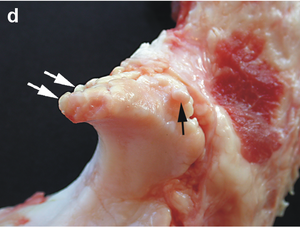Osteophytes
| Bone spur | |
|---|---|
 |
|
| Small marginal osteophytes (arrows) of the processus anconeus of the ulna can be seen in this gross pathological specimen of a sow. | |
| Classification and external resources | |
| Specialty | Orthopedics |
| ICD-10 | M25.7 |
| ICD-9-CM | 726.91 |
| DiseasesDB | 18621 |
| MeSH | D054850 |
Osteophytes, commonly referred to as bone spurs are bony projections that form along joint margins. They should not be confused with enthesophytes, which are bony projections that form at the attachment of a tendon or ligament. Osteophytes are not always distinguished from exostoses in any definite way, although in many cases there are a number of differences.
Osteophyte formation has been classically related to any sequential and consequential changes in bone formation that is due to aging, degeneration, mechanical instability, and disease (such as diffuse idiopathic skeletal hyperostosis). Often osteophytes form in osteoarthritic joints as a result of damage and wear from inflammation. Calcification and new bone formation can also occur in response to mechanical damage in joints.
Osteophytes form because of the increase in a damaged joint's surface area. This is most common from the onset of arthritis. Osteophytes usually limit joint movement and typically cause pain.
Osteophytes form naturally on the back of the spine as a person ages and are a sign of degeneration in the spine. In this case, the spurs are not the source of back pains, but instead are the common symptom of a deeper problem. However, bone spurs on the spine can impinge on nerves that leave the spine for other parts of the body. This impingement can cause pain in both upper and lower limbs and a numbness or tingling sensations in the hands and feet because the nerves are supplying sensation to their dermatomes.
...
Wikipedia
